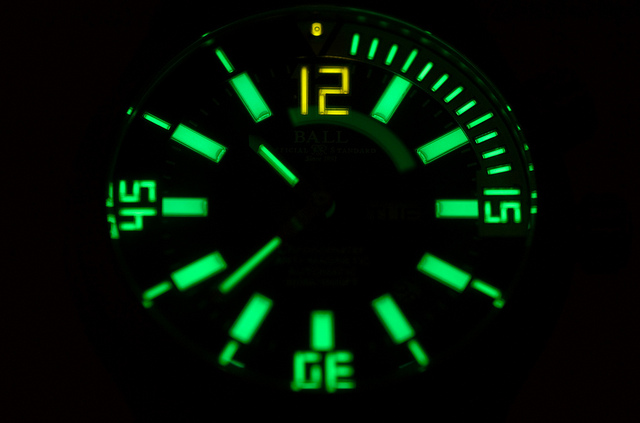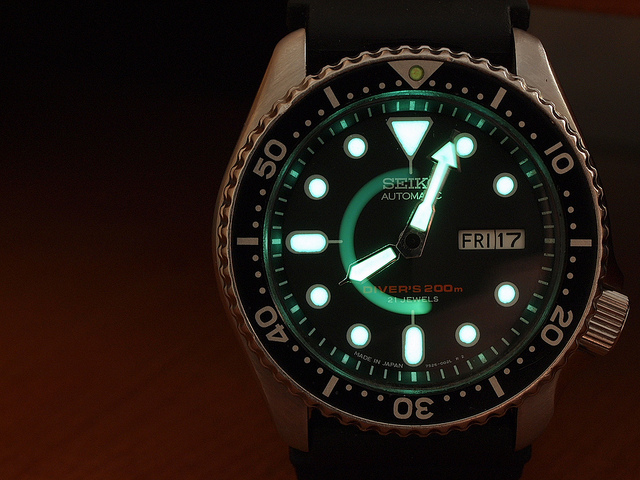Although bright lume is not the most important feature for a good dive watch, it’s still really a big plus. Have you ever wondered why 2 diving pieces in the same price range offer different lumes? One is so strong and bright, and the other seems too weak? Why your watch’s lume dies out in a few hours but your friend’s can glow all night long?
It may be not the matter of craftsmanship or quality. The reason is mainly because these 2 watches use different lume technologies! It’s similar to the fact that a traditional mechanical watch can never be as precise as a quartz piece no matter how well it’s made!
In this article, I’m going to list out some of the most common types of lume being used on dive watches, each has its own pros and cons. So next time when you buy a new diver’s piece, you can predict what its lume looks like by knowing which lume-tech the watch applies.
Radio-active
Its name does all the talking! This kind of lume is created by radiation reaction. There’re so many radio-active substances that can self-glow brightly in the dark. But along with the high level of energy emitted, they also have some adverse effects on human health.
Radium once was the most common substance used after the World War I, but watchmakers soon had to replace it with other kinds of weaker radio-active substances. A tiny amount of radium in each wristwatch cannot do harm to wearers, but workers in watch factories have been exposed to a much greater amount for a long time.
An ideal replacement for radium is tritium, which is still being used nowadays. Tritium is a low-energy beta emitter. These beta particles cannot penetrate through the watch case to contact human body. Tritium is a much safer lume-solution compared to radium or other strong radio-active substances.

Radio – active lume doesn’t need charging, so you can use your watch in total darkness as long as you want. However, its glow is rather weak because high-energy emitters cannot be applied to wristwatches!
Tritium tubes on your watch need replacing after about 20 years because this lume material just has a 12-year half-life, the glow intensity will decrease overtime. Those who wanna buy vintage dive watches have to pay a little extra for lume replacement because most of them feature radio-active lume.
Photoluminescence
In replacement of radio-active lume, watchmakers applied a whole new technology based on photoluminescence. This is a process in which a substance re-radiates photons after absorbing them from a strong light source. This kind of lume is not self-powered like the radio-active type, that’s why it will fade out very soon.
Some popular trademarks of photoluminescent lumes are Super Luminova (of Luminova company), LumiBrite (of Seiko)…In essence, these companies apply the same technology of photoluminescence, but they use different compounds to get the job done.

In general, the photolumimescent lume is brighter than the radio-active one. But while the Super Luminova C1 lume is just slightly better, the C3 is at a total different level, both in terms of glow longevity and intensity. After a full charge, the C3 lume can glow at its full bright for about 10 mins, and then maintaining transparent legibility for more than 3-5 hours. What about the C1? You will see its light dies out in 45 mins, and at its best, it’s still much dimmer than the C3.
The LumiBrite lume offer the same quality as the Super Luminova C3, which is “10 times better than conventional luminous paint” in Seiko’s words. Here we can talk about quality difference, Seiko & Citizen are among the few watchmakers who dare to invest in an outstanding lume for their entry-level dive watches. As I said above, the bright lume is not a must, but it’s a big plus!
Verdict
There’s a lot more information about lume technologies that you can find on Google. I just want to list out here some basic things that is most useful for you in choosing a diver’s watch. Remember that radio – active lume is rarely used on today’s wristwatches, photoluminescent type is the most common now. The lume quality varies from watch to watch, an expensive timepiece may not have a better lume compared to a cheaper one.
Leave a Reply